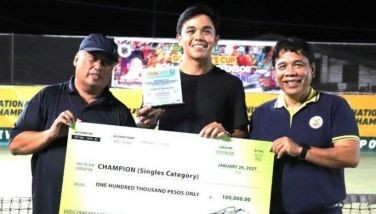Tribal Games: Focus on tradition, culture
Lost in all the news stories, articles and discussions about sports is the role sports plays in promoting Philippine culture, biodiversity and sustainable development. Many sectors, including media, have regarded sports, both western-created and even sports of Asian origin such as judo, taekwondo, muay thai, arnis, and sepak takraw, as pure competitive activities that have little to do with preserving indigenous culture and traditions.
In fact, many do not even have any notion of the role sports plays in national development. To many, sports is merely a matter of organizing games and competitions. We therefore become encouraged and hopeful when the POC (Philippine Olympic Committee) Online, the official weekly online newsletter of the POC, has for its lead story, an article written by Shai Tamayo, headlined, “Tribal Games go to Mindoro.”
In her article, Tamayo states that “the far out flat lands in sleepy Barangay Talabaan in laid-back Maburao (Mindoro Occidental) stirred to life when the truckload of katutubos arrived to compete in their first-ever tribal games (TG).” Clad in their traditional bahag, the timid Mangyan-Iraya tribes people, sometimes called Sandugo, hit it off with somewhat traditional bow and arrow skills. Enthusiasm and confidence escalated as the games progressed.
By the end, their unpracticed skill breathed new life. Typically shy Mangyans were transformed into proud and inspired tribal athletes. Some 37 Mangyan katutubos, aged 17 to 60 years, competed in four events: standing and squatting archery, archery assault course, sibat (javelin) throwing and foot relay race. The last two events were conducted by the shore, against the backdrop of wild waves heralding Typhoon Ondoy’s arrival.
The TG is the product of the joint efforts of the ASEAN Center for Biodiversity (ACB) and the POC to showcase how indigenous people (IP) conserve their natural environments and generate a greater awareness for biodiversity conservation among the peoples of the ASEAN region. The end result is the first “POC-ACB Tribal Games,” which has for its theme, “Protecting our Natural Heritage.” The Mangyan, Aeta and Dumagat (MAD) factsheet says that “Olympians advocate Olympism. Environmentalists advocate biodiversity.”
Together, POC and ACB promote the tribal games, known as the POC-ACB MAD Tribal Games, with the objective of protecting our natural heritage. The project therefore focuses time, effort and energy on the guardians of natural biodiversity, the tribes of MAD. The Philippine TG is a pilot project of the POC and the ACB. The 2009 games is the preparatory stage for 2010, the International Year of Biodiversity, when the TG is envisioned to draw the participation of the 10 ASEAN member states through their respective National Olympic Committees.
The ACB and the POC recognize the key role that indigenous people’s play in conserving flora, fauna and other biological resources. For millennia, indigenous peoples have developed a relationship with their environment that has sustained and nourished their bodies, fostered community relations and strengthened their culture. Local communities which depend on their environment for food and livelihood have also developed such ties with nature. MAD says that this is a relationship that respects the changing of the seasons, life cycles of crops and livestock, and the significance of all forms of life on earth.
MAD emphasizes that this synergy between humans and the environment embodies the form of conservation that people aspire for. It is a relationship that ultimately demonstrates the sustainable use and equitable sharing of resources that governments have aimed forever since the alarm was rung for the need to conserve biodiversity during the Earth Summit in 1992.
The POC-MAD Tribal Games have three competition levels: intramurals among the MAD tribes in Pampanga, Quezon and Occidental Mindoro; second level: final competition among regional winners at Clark Field in Pampanga in conjunction with the Annual Aetas’ Festival; and the ASEAN tribal games for the International Year of Biodiversity in 2010. It is hoped that the project will bring together students, youth, and the general public on a personal encounter with the tribes to get first-hand information on how to protect and appreciate the environment.
The Aeta competition in Mabalacat, Pampanga drew some 40 entries which included Bernard Santos who, according to a philstar.com report, scored 99.8 percent for first place in the sibat throwing competitions.
I am glad that tribal or indigenous games have finally gotten off the ground. This was one advocacy that I had tried to promote during my watch at the Philippine Sports Commission.
- Latest
- Trending



























